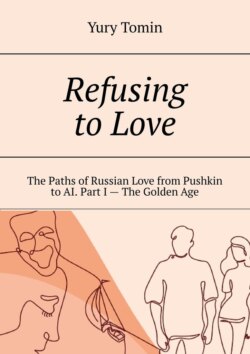Читать книгу Refusing to Love. The Paths of Russian Love from Pushkin to AI. Part I – The Golden Age - Yury Tomin - Страница 5
III
ОглавлениеFrom ship to ball. Elegant pas of tender feelings. The new framework of love. The cult of striving for the ideal. Faces of beauty. Incarnations of romantic dreams. The imaginary reality of the ideal. Divine creation
If one were to imagine a time-traveling explorer setting off after meeting the Yalom couple to the origins of Russian love, he would certainly get to a large formal gathering for social dancing, where he would meet Pushkin, Lermontov, and other participants and chroniclers of the heyday of the Romantic era in Russia. The ball was the center of love – romantic fantasies matured in anticipation of the ball, during the dance signals of attraction were transmitted and sparks of lofty feelings flashed, after the ball the trajectory of romantic experiences rushed on the wings of found hope up or plunged into the chaos of mental turmoil.
It is safe to say that love ruled the ball, as well as the fact that the ball ruled love – made up its entourage, set the style, manners, patterns, and established the unspoken rules of love. To imagine the romantic atmosphere of a ball can be contrasted with the suppression of open expression of feelings and sexual desires in the Middle Ages era, famous for religious asceticism, accusing beautiful women in satanic sins, the church regulation of marriage. However, the spirit of the ball was also alien to the rigorous reasoning and cold mechanicism of the Enlightenment, which prevailed over the «dark ages.» The high society, exposing itself at balls, welcomed, within certain limits, the freedom of feelings and manners, but considered a demonstration of intelligence excessive. An exception was made only for geniuses, especially poets. But their position in high society was unenviable, since social status and, consequently, the attractiveness of the groom was still determined by wealth, nobility and government rank.
All these special features of the new environment, in which young minds and hearts were immersed in the early 19th century in Russia, formed a fairly slender and ramified model of culture, which is now called romanticism. In romanticism, everything is permeated with the cult of the ideal and awe of feelings in the pursuit of it.
The ball seemed to be the earthly embodiment of the desired ideal, where it could be encountered by chance or found after making the necessary preparations. It presented faces of beauty, models of grace and perfection, nobility and dignity – everything that the human soul sooner or later aspired to and longed for. The imaginary reality and visual proximity of the ideal made the heart beat faster, excited the blood, generated plans for the realization of the cherished dream and pushed to action to fulfill them.
Along with the expectation of meeting a romantic dream with its embodiment, the ball also set the standards of presentation in the form of the dress code, as well as in the manner of communication, the ability to dance and maintain small talk. Some of this set could be bought and some could be learned, but most of all natural beauty was appreciated, which was perceived as divine. The great poet Alexander Pushkin became a victim of the passion of possessing such an unearthly beauty.
Ball scene. Unknown artist, 1829. State Hermitage
